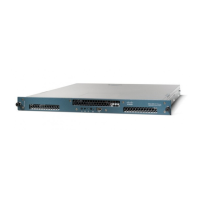Chapter 4 Configuring Class Maps and Policy Maps
Class Map and Policy Map Overview
4-2
Cisco 4700 Series Application Control Engine Appliance Administration Guide
OL-11157-01
This chapter contains the following major sections:
• Class Map and Policy Map Overview
• Class Map and Policy Map Configuration Quick Start
• Configuring Layer 3 and Layer 4 Class Maps
• Configuring Layer 7 Class Maps
• Configuring a Layer 3 and Layer 4 Policy Map
• Configuring a Layer 7 Policy Map
• Applying a Service Policy
• Class Maps and Policy Map Examples
• Example of a Traffic Policy Configuration
• Viewing Class Maps, Policy Maps, and Service Policies
Class Map and Policy Map Overview
You classify inbound network traffic destined to, or passing through, the ACE
based on a series of flow match criteria specified by a class map. Each class map
defines a traffic classification: network traffic that is of interest to you. A policy
map defines a series of actions (functions) that you want applied to a set of
classified inbound traffic.
Class maps enable you to classify network traffic based on the following criteria:
• Layer 3 and Layer 4 traffic flow information—Source or destination IP
address, source or destination port, virtual IP address, IP protocol and port,
or management protocol
• Layer 7 protocol information—HTTP cookie, HTTP URL, HTTP header,
HTTP content, or FTP request commands
The traffic classification process con
sists of the following three steps:
1. Creating a class map by using the class-map command and the associated
match commands, which comprise a set of match criteria related to Layer 3
an
d Layer 4 traffic classifications or Layer 7 protocol classifications.
2. Creating a policy map by using the policy-map command, which refers to the
class maps and identifies a series of actions to perform based on the traffic
match criteria.

